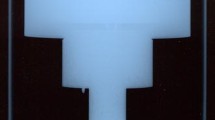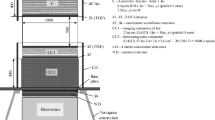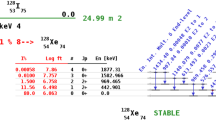Abstract
Calculations of current-forming processes in a direct-charge rhodium detector are presented. The calculations are performed using two well-known programs – EGS4, which uses the Monte Carlo method to describe the combined transport of electrons and γ rays, and the MCU code, similar to the neutron code, from which, in this case, modules which are not present in EGS4 and which describe the source, geometry, and detection were used. The two codes were combined by means of an interface. Good agreement was obtained with calculations performed by other authors using the similar ITS code. It was found that the results depend strongly on the β spectrum employed.
Similar content being viewed by others
REFERENCES
E. A. Gomin, S. V. Marin, and S. A. Tsimbalov, “MCU code. Calculation of the transfer function of a 9-emission neutron detector,” Preprint IAÉ-5755/5 (1994).
ITS Version 3.0: The Integrated Tiger Series of Coupled Electron and Photon Monte Carlo Transport Codes, SAND91-1634.
MCNP - A General Monte Carlo N-Particle Transport Code, Version 4B, LA-12625-M (1997).
W. Nelson, H. Hirayama, and A. Bielajev, “The EGS4 code system.” Stanford Linear Accelerator Center Report SLAC-265 (Stanford, California) (1985); see also http://ehssun.lbl.gov/egs/egs.html.
E. A. Gomin, L. V. Maiorov, M. I. Gurevich, et al., “MCU-RFFI/A Code with SDLC/MCUDAT-1.0 constants library,” Russian Federal Inspection Agency for Nuclear Radiation Safety. Registration number of the Rating Certificate No. 61, October 17, 1996.
T. Ober and J. Malloy, “An advanced model for the prediction of the total burnup-dependent self-powered radium detector response,” in: Proceedings of International Conference on Mathematics and Computations, Reactor Physics and Environmental Analysis, Portland, Oregon (1995), Vol. 2, pp. 22–31.
H. Warren, “Neutron and gamma ray effects on self-powered in-core detectors,” Nucl. Sci. Eng., 54, 391–415 (1974).
V. Orphan, N. Rasmussen, and T. Harper, “Line and continuum gamma-ray yields from thermal neutron capture in 75 elements,” GA-10248, July 31, 1970.
V. G. Aleksankin, S. V. Rodichev, P. M. Rubtsov, et al., Handbook on Beta-and Antineutrino Radiation from Radioactive Nuclei, Énergoatomizdat, Moscow (1989).
M. Baldwin and J. Rogers, “Calibration of self-powered neutron flux monitor in a simulated PWR lattice,” Nucl. Sci. Eng., 16(1), 171–176 (1969).
Author information
Authors and Affiliations
Rights and permissions
About this article
Cite this article
Gorodkov, S.S. Monte Carlo Calculation of the Activation Current of a Rhodium Neutron Detector. Atomic Energy 92, 15–20 (2002). https://doi.org/10.1023/A:1015046411801
Issue Date:
DOI: https://doi.org/10.1023/A:1015046411801




